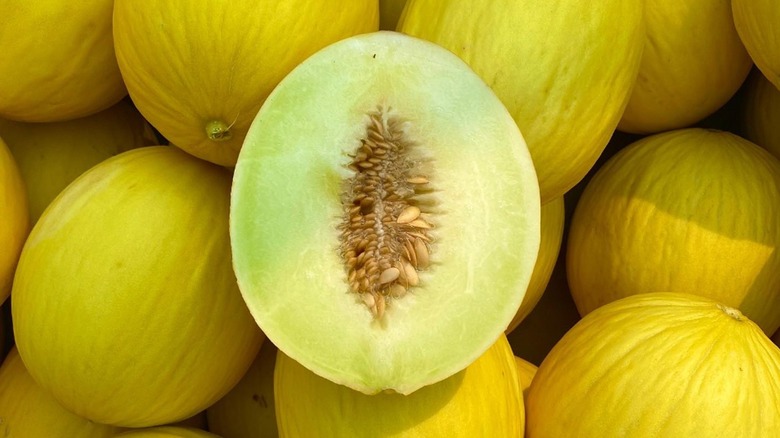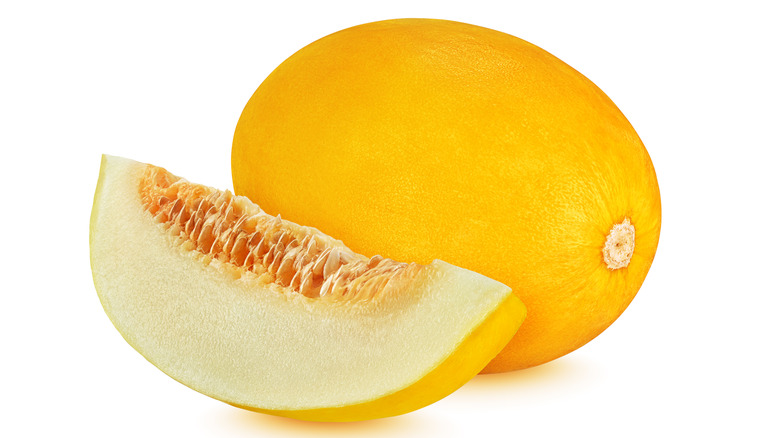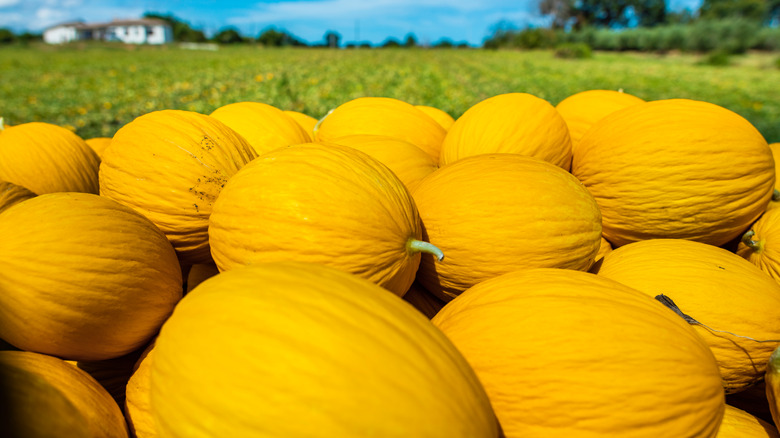What Are Canary Melons And Where Can You Find Them?
Just the word "canary" brings to mind lively little chirpy birds with blazing yellow coats and feathers. It's no wonder a juicy melon wrapped in the same brilliant hue would carry the same name. In many countries, including the United States, the elusive canary melon (Cucumis melo) falls within the "specialty produce" category, simply because of its relatively limited availability.
But those who've experienced the sweet, tangy flavor of canary melons are likely to seek them out once summer finds its stride. These melons have a short season, ranging from roughly June through August, or sometimes into the mid-autumn months, depending on the region. But they're a very hardy fruit that travels well, extending their availability.
Canary melons are identifiable by their eye-catching yellow rinds. But it's not just the color that distinguishes them. Instead of the typical round shape of cantaloupes or honeydews, the canary resembles a football with its long, oblong contour that tapers into a congregated pinch at each end. It sports a thick, durable rind with a curiously "wrinkled" appearance when ripe, which belies the lusciousness lurking beneath the surface.
Enjoying the glory of sweet canary melons
If sweet and tangy ever danced a passionate tango, perhaps it would taste something like the canary melon. The tough exterior opens to a pale garden of creamy white flesh with tinges of light tea-green hues. The juicy succulence is both mild and tangy, driven by a sweetness lying at 13.9 on the Brix scale for measuring the ratio of sugar to water inside fruit. The levels tend to increase as a piece of fruit, such as a melon, ripens. By comparison, an average cantaloupe Brix is 10 and generally maxes out at about 12.
The sweetness of a canary melon, accompanied by a zingy-yet-tender complexity, makes it stand out as an enticing anomaly amongst its melon-clan relatives. With weights up to five pounds, there's plenty of lushness to share, as well as generous nutrient bonuses of vitamins D, A, potassium, and fiber.
The light, subtly spicy taste of canary melons perks up sultry summer days when eaten cold, either in chunks and slices or dropped into salads and smoothies. Try mixing them into your favorite sorbet or cocktail recipe, or mash them for infusing homemade melon jam. But don't miss out on the super sweetness that emerges when these melons interact with heat. Try baking them into cookies and cakes, or toss them onto the grill for a seared sweet/smokey/tart flavor twist.
Where to find canary melons
Unlike its chirpy yellow avian counterpart, the canary melon is a quiet beauty, resting unobtrusively in specialty markets and farmer's stands when in season. They grow predominantly in California's San Joaquin Valley but also have limited cultivators in the state's southern region and across the state border into Arizona. In these areas, you're more likely to find them in local grocery stores and select produce markets.
Some specialty produce distributors provide wider access, both online and in some supermarkets. Melissa's Produce sources specialty fruits from across the globe as well as regionally, selling directly to individuals and supplying several other online vendors with hard-to-find fruit. The company maintains a dedicated web page for canary melons, noting its seasonal availability in June through August.
If you live in an area with plenty of heat and space to accommodate 10-foot vines and two-foot-high plants, it's quite possible to grow canary melons at home. They'll need lots of sunshine and water while progressing toward ripeness for roughly three months after planting. You'll find the seeds available from many online nurseries and seed suppliers.



